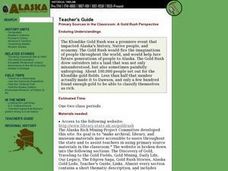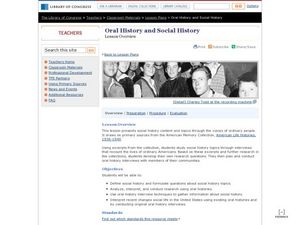Curated OER
Seeking a Fortune in 18th Century Maritime Boston
Study the Revolutionary War era practice of recruiting seamen to prey upon the British shipping industry, and discuss the impact this practice had on the Colonial war efforts. Learners read and interpret recruiting advertisements for...
Curated OER
Pictures from Korea: Shards of an Almost Forgotten Past
Students explore the Korean War through photography. In this Korean War lesson, students examine photographs taken by a soldier and respond to question about them.
Curated OER
In The Words of Abraham Lincoln...
Students explore the words of Abraham Lincoln. In this Abraham Lincoln instructional activity, students analyze segments of "The Gettysburg Address," his annual address to Congress in 1862, and his letter to Mrs. Bixby. Students conduct...
Curated OER
Sima Qian: Records of the Grand Historian
Print this resource and activate prior knowledge about Ancient China. This page includes a quote from Sima Qian and two critical thinking questions related to the dynastic system in China.
Curated OER
Excerpt from Edward Bain's The History of Cotton Manufacture in Great Britain (1835)
Great Britain was where the industrial revolution began. The class reads an excerpt from a document written in 1835 describing cotton manufacture in Great Britain. They then answer two critical analysis questions.
Curated OER
Hugh Miller's The Old Red Sandstone (1841)
Pollution has been an issue since the advent of stratified society. Learners will read this excerpt from Hugh Miller's The Old Red Sandstone (1841) then answer two document-analysis questions.
Curated OER
Excerpt from Elizabeth Gaskell's Mary Barton (1848)
Answering document-based questions is a great way to build reading comprehension and critical thinking skills. Learners read an excerpt from Elizabeth Gaskell's Mary Barton, then answer two related questions.
Curated OER
After: A Study of Individual Rights
Use the dystopian novel After by Francine Prose to spark discussion about individual and student rights. Learners read the novel, evaluating how far a school can go to control its attendees. As they read, scholars...
Curated OER
The Star-Spangled Banner
Get your kids moving as they learn about the history of the United States National Anthem. Scholars examine the War of 1812, Francis Scott Key, and the meaning behind The Star Spangled Banner as they listen to an 18-minute...
Curated OER
Civil War Photographs: What Do You See?
A study of an image from The Library of Congress collection Civil War Photographs 1861-1865 launches an investigation of the connection between the Civil War and American industrialization. After analyzing “Petersburg, Va. The...
Curated OER
The Dust Bowl: Out of the Dust
Is your class going to read the novel, Out of the Dust? If so, you can prep them with a presentation that provides both images of the Dust Bowl and quotes from the book. Tip: Have learners use the images to compose descriptive...
Curated OER
Document-Based Essay on U.S. Reaction to North Korean Nuclear Policy
Students compose essays on nuclear policies. In this North Korea lesson, students examine political cartoons and primary documents regarding nuclear build-up by North Korea. Students write essays about North Korea's military goals and...
Curated OER
Part III: Document-Based Question
Need a DBQ practice set? Whether or not your class is preparing for the AP exam, learners will benefit from analyzing primary source documents about economic and social change. For Part A, the short-answer questions, participants read...
National Endowment for the Humanities
The Road to the Constitutional Convention
After defeating the most powerful nation in the world, the United States had to deal with its own weaknesses in the Articles of Confederation. Activities in the lesson include analyzing primary sources from the Founding Fathers to...
Curated OER
Primary Sources in the Classroom: A Gold Rush Perspective
Students develop and hone their historical inquiry and analytical abilities. They draw up a list of 20 essential items they would have to bring to survive one year as a Gold Rush stampeder.
Library of Congress
Oral History and Social History
Learners examine the Great Depression. In this oral and social histories instructional activity, students analyze primary sources to develop an understanding of the America in the 1930's.
Curated OER
What was Rationing?
Students analyze primary source documents to learn about World War II. In this world history lesson, students use cheese and bread rationing coupons issued during the second World War to gather information about the documents and the...
National History Day
“War Is Hell. We Know it Now.” American Soldiers in the Meuse-Argonne Offensive
Understanding the soldier's experiences during World War I sometimes takes a newscast. Learners see the importance of understanding multiple points of view with a newscast project surrounding the Meuse-Argonne Offensive. Compare and...
Roy Rosenzweig Center for History and New Media
European Explorers
To compare how the Spanish, French, and English approached the exploration of North America, class groups examine primary source documents and become experts on one of four explorers: Francisco Coronado, Robert LaSalle, Samuel de...
Curated OER
Unit 2: Post-Revolution: The Critical Period 1781-1878
The post-Revolutionary Period of 1781-1787, also known as the Critical Period, is the focus of a series of lessons that prompt class members to examine primary source documents that reveal the instability of the period of the...
Curated OER
Billie Holiday's Song "Strange Fruit"
Pupils analyze a variety of primary source materials related to lynching (news articles, letters written to or written by prominent Americans, pamphlets, broadsides, etc.) in order to assess the effectiveness of the anti-lynching...
Humanities Texas
A President's Vision: George Washington
Who knew that one poster about George Washington could have so many learning possibilities attached to it? Here you'll find an attractive learning display on the first president of the United States, as well as worksheets and...
Curated OER
The Chesapeake Bay in Captain John Smith's Time
When Captain John Smith visited the Chesapeake Bay in the summer of 1608, what types of animals and habitats did he encounter? Your young historians will analyze primary source documents to answer this question, as well as compare...
Texas State Energy Conservation Office
Fueling the Future
Future mechanical engineers and automotive technicians read about various solutions to using gasoline in cars. Included are electric, fuel-cell-powered, and hybrid vehicles.
Other popular searches
- Using Primary Sources
- Wwi, Primary Sources
- Rosa Parks Primary Documents
- Gilded Age Primary Sources
- Working With Primary Sources
- Primary Resources Hsie
- Web Quests Primary Sources
- Ancient Rome Primary Sources
- 1920 1929 Primary Sources
- Primary Sources and Family
- Conscription Primary Sources
- Scotland Primary Sources























